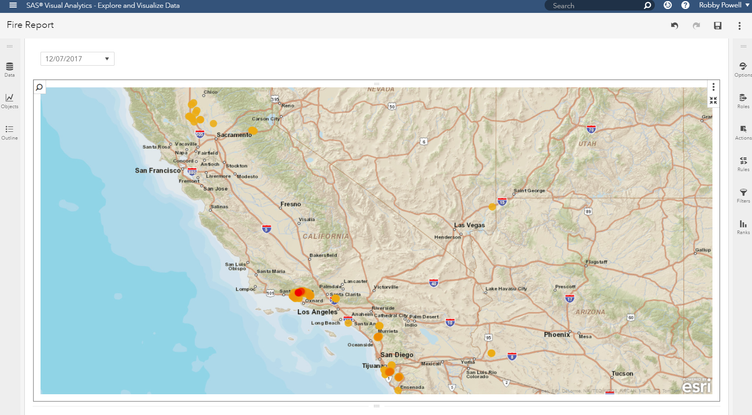- Home
- /
- SAS Communities Library
- /
- Clustering data points in SAS Visual Analytics 8.2 gives more perspect...
- RSS Feed
- Mark as New
- Mark as Read
- Bookmark
- Subscribe
- Printer Friendly Page
- Report Inappropriate Content
Clustering data points in SAS Visual Analytics 8.2 gives more perspective - a fire hot spot example
- Article History
- RSS Feed
- Mark as New
- Mark as Read
- Bookmark
- Subscribe
- Printer Friendly Page
- Report Inappropriate Content
The 2017 U.S. California fire season was the worst in history with the Thomas Fire being the largest California wildfire since record keeping began. Catastrophic events such as this require a massive response, and frequently changing conditions require time-sensitive changes.
![CF Fire.jpg Scott L - Los Angeles, USA (1_E1C9469) [CC BY-SA 2.0 (https://creativecommons.org/licenses/by-sa/2.0)], Wikimedia Commons](https://communities.sas.com/t5/image/serverpage/image-id/17703iB2D483A52CDCA2BF/image-size/large?v=v2&px=999)
Fire Management officials rely on visualizing data from a variety of sources to decide where to best deploy firefighters and resources. Unfortunately, data can have different meaning based on perspective. Even the most accurate and up-to-date information can produce visualizations that lead to seemingly-uninformed conclusions.
Relying on a single data visualization may lead to incorrect assessment due to an optical illusion that obscures the underlying facts. To get the complete picture, it is important to view various perspectives before acting. An example of this in action involves data points on geographic maps. In situations where there is high saturation of data for a relatively small area there is risk of data points being overlapped and hidden by other data points. This illusion can mask the event intensity in those areas.
The SAS Visual Analytics geo-map below shows individual wildfire hot spots in California on December 7th, 2017.
From this map, you can tell there are three primary clusters of hot spots in California. It is evident that some hot spots in central-southern California are more intense – based on the red markers, but otherwise the clusters appear similar. From this visualization, the decision may be made to send a slightly higher number of firefighters to the more intense central-southern cluster, and to send fewer firefighters to the clusters of fires in northern and southern parts of the state.
To make sure you’re not missing something, it’s a good idea to consider other perspectives, such as the possibility the quantity of hot spots is being masked due to overlapped data points. SAS Visual Analytics 8.2 provides that perspective by clustering adjacent markers, as seen below.
By selecting “Cluster adjacent markers” SAS Visual Analytics replaces individual markers with a single marker representing a map area and showing the number of markers existing in that area. While you no longer see the intensity, this perspective shows you the quantity.
Based on this new perspective you see the cluster of fires in south-central California contains 306 hot spots while the other two clusters contain 19 and 47 hot spots. Based on this information, which is not obvious in the previous map, a different decision is likely to be made resulting in a much higher number of firefighters being sent to fight the fires in south-central California - the larger cluster.
It is essential that data visualization tools provide decision-makers with multiple perspectives of their data to remove optical illusions and enable informed, accurate decisions. While the challenges you face and decisions you make may not be to combat a 281,900-acre wildfire, finding meaning in your data and determining where to focus your time and resources is critical to the success of your business. Capabilities in SAS Visual Analytics 8.2, such as Cluster adjacent markers let you see more of what your data has to show.
We acknowledge the use of data and imagery from LANCE FIRMS operated by the NASA/GSFC/Earth Science Data and Information System (ESDIS) with funding provided by NASA/HQ.
MODIS Collection 6 NRT Hotspot / Active Fire Detections MCD14DL. Available on-line [https://earthdata.nasa.gov/firms] DOI: 10.5067/FIRMS/MODIS/MCD14DL.NRT.006
April 27 – 30 | Gaylord Texan | Grapevine, Texas
Registration is open
Walk in ready to learn. Walk out ready to deliver. This is the data and AI conference you can't afford to miss.
Register now and lock in 2025 pricing—just $495!
SAS AI and Machine Learning Courses
The rapid growth of AI technologies is driving an AI skills gap and demand for AI talent. Ready to grow your AI literacy? SAS offers free ways to get started for beginners, business leaders, and analytics professionals of all skill levels. Your future self will thank you.


